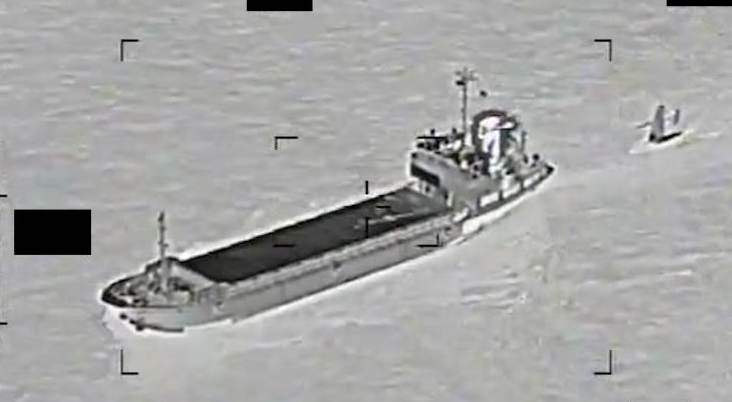The Pentagon announced Tuesday Iran had been caught stealing an unmanned U.S. drone ship in the Arabian Gulf overnight.
The Iranian ship cut the line towing the U.S. drone ship after being confronted by a U.S. patrol ship and a Sea Hawk helicopter.

Photo By NAVCENT Public Affairs | ARABIAN GULF (Aug. 30, 2022) Screenshot of a video showing support ship Shahid Baziar, left, from Iran’s Islamic Revolutionary Guard Corps Navy unlawfully towing a Saildrone Explorer unmanned surface vessel in international waters of the Arabian Gulf, Aug. 30. (U.S. Navy photo)
The U.S. Navy prevented a support ship from Iran’s Islamic Revolutionary Guard Corps Navy (IRGCN) from capturing an unmanned surface vessel operated by the U.S. 5th Fleet in the Arabian Gulf, Aug. 29-30.
While transiting international waters around 11 p.m. (local time), Aug. 29, U.S. 5th Fleet observed IRGCN support ship Shahid Baziar towing a Saildrone Explorer unmanned surface vessel (USV) in an attempt to detain it. U.S. Navy patrol coastal ship USS Thunderbolt (PC 12) was operating nearby and immediately responded. U.S. 5th Fleet also launched an MH-60S Sea Hawk from Helicopter Sea Combat Squadron 26, based in Bahrain.
The actions taken by U.S. naval forces in response resulted in the IRGCN vessel disconnecting the towing line to the USV and departing the area approximately four hours later. The U.S. Navy resumed operations without further incident.
“IRGCN’s actions were flagrant, unwarranted and inconsistent with the behavior of a professional maritime force,” said Vice Adm. Brad Cooper, commander of U.S. Naval Forces Central Command, U.S. 5th Fleet and Combined Maritime Forces. “U.S. naval forces remain vigilant and will continue to fly, sail and operate anywhere international law allows while promoting rules-based international order throughout the region.”
The Saildrone Explorer USV the IRGCN attempted to confiscate is U.S. government property and equipped with sensors, radars and cameras for navigation and data collection. This technology is available commercially and does not store sensitive or classified information.
U.S. 5th Fleet operates a network of manned and unmanned systems in accordance with international law. The integration of unmanned systems and artificial intelligence into fleet operations enhances maritime vigilance for U.S. forces and international partners in waters across the Middle East.
Video:
A saildrone is a wind and solar-powered unmanned surface vehicle (USV) capable of up to 12-month data collection missions on the open ocean. In October 2013, a saildrone nicknamed Honey Badger (these days Saildrone’s USVs are known only by a number) completed the first “no-handed” Pacific crossing, sailing 2,248 nautical miles in 34 days from San Francisco to Hawaii.
Early Saildrone Explorer prototypes were designed with a narrow hull supported by two outriggers; the latest design is that of a 23-foot hull and a deeper, heavier keel. They are powered by a 15-foot wing, which is effectively a sail like on a sailboat, but of a design more similar to the wing on an airplane. Wind passing over the wing produces thrust, and a small tab on the end of the tail attached to the wing controls the angle of attack. The rudder controls the direction of the hull, and the keel keeps the saildrone upright. The Saildrone Explorer is used primarily for science data collection and single-beam ocean mapping. There are also two larger platforms: The 33-foot Voyager is designed for maritime security and ocean mapping and the 72-foot Surveyor is designed for deep-ocean multibeam mapping. Download vehicle product cards.
Saildrone USVs are equipped with GPS and an onboard computer, enabling the vehicles to navigate following prescribed waypoints, while staying in a safety corridor, taking winds and currents into consideration autonomously. All vehicles are supervised 24/7 by trained operators at the Saildrone Mission Control in Alameda, CA.
Saildrone video:
CENTCOM commander General Michael Kurilla praised the crew of the Thunderbolt:
Here is a statement from the CENTCOM commander on an attempted seizure of a U.S. unmanned vessel by the Islamic Revolutionary Guard Corps Navy.
[1 of 3] pic.twitter.com/oEPsH2gsgK
— U.S. Central Command (@CENTCOM) August 30, 2022
The post Pentagon Announces Iran Caught Stealing US Drone Ship appeared first on The Gateway Pundit.
